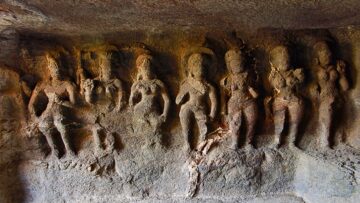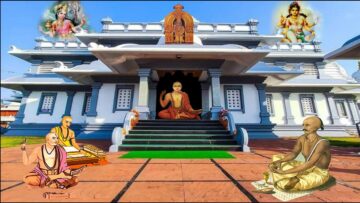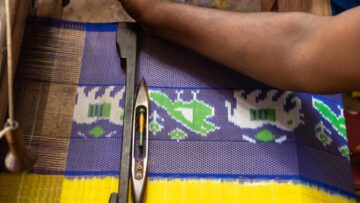Introduction
In the first part of this article, we traced the development of the peacock motif in Indian literature, religion, culture, history and geography. In this article, we will take a critical look at the use of the peacock motif in the arts and crafts of India.
Most motifs used in Indian art served more than one purpose. They were not merely means to decorate a fabric or a surface, but also had a deeper, symbolic meaning. Some motifs were harbingers of fertility and prosperity to the wearer, while, some like the Vyala and Gandabherunda served as protective charms, warding off evil. Motifs like the peacock reflect stories from our scriptures. The peacock is also a symbol of our deep communion with nature as a civilization. The peacock possesses grace, beauty and symmetry that has made it a favorite of the artists across India for more than five millennia!
Peacock in Indian Textiles
In the royal Kanchipuram weave of Tamil Nadu, the peacock or mayil as it is referred to in Tamil, acquires a very special place. In all of Tamil Nadu, the peacock is considered as sacred as it is the vahana of Shri Kartikeya. The bird is therefore, a symbol of power, royalty and beauty.
Yapperungalam, a 12th century text on Tamil prosody, written by a Jain monk Amritasakaran, describes the city of Kanchipuram as peacock shaped with the Varadrajaswami Perumal temple as the head of the peacock, while Siva Kanchi forms its body.

The weavers of Kanchipuram have used the peacock motif extensively in the sarees they weave. You can see the peacock on borders of the sarees, on the end piece or pallu, as well in small motifs all over the body of the saree. The mayilchakram, or alternating peacock and wheel is a favorite motif of Kanchipuram weavers for bridal sarees.

In the Paithani saree of Maharashtra, the peacock motif occupies a pride of place, with the bangdi-mor design, or the peacock inside a bangle design being the most prized one as it is the most complicated motif to weave.


In the famed double ikat Patola of Patan, the peacock is often featured in combination with other motifs like the parrot, the elephant or a butterfly. A design called MorPatangyaBhat features alternating peacock and patangya or butterfly motif. A dancing peacock symbolizes coming of the rains and prosperity, while the butterfly symbolizes beauty. In another design called the PopatMorBhat, parrot and peacock are alternated. Parrot is the symbol of beauty and peacock is the symbol of fertility and prosperity.

In the brocades of Banaras, where geometric, floral and abstract motifs were preferred over animal motifs by the mainly Muslim weavers, the peacock continued to be a favored motif, especially for borders, due to its beauty, grace and magnificent plumage.
Peacock In Embroidery
As seen earlier, the peacock has been an integral part of the artistic traditions of India. It signifies beauty, royalty, love, rebirth and passion. The peacock motif has been widely adopted as a motif in the various embroidery techniques used in different parts of India. In the phulakari embroidery of Punjab, the peacock is often embroidered on the dupatta of a new bride.

In the embroidery of Karnataka, a geometric peacock is often used on the sleeves of a young girl’s blouse and on the pallu of a saree of a new bride, as it is a motif strongly associated with beauty and passion.

In the Rabari embroidery of Kutch, the peacock motif is often embroidered with mirrors to decorate the lower hem of the ghagro or the skirt of women, so that when the skirt catches the sunlight, the motif sparkles like diamonds.

In the Kantha embroidery of West Bengal, simple running stitches are used to embroider the peacock motif.
 In the zardozi embroidery much favored by couturiers these days, the peacock is favorite motif used to decorate everything from blouses to lehengas.
In the zardozi embroidery much favored by couturiers these days, the peacock is favorite motif used to decorate everything from blouses to lehengas.

Peacock in Islamic Art
While the peacock was considered a sacred bird by the Hindus, Jains and Buddhists, the Islamic rulers of India were enamored by the bird because of its sheer beauty. In Islamic art, the peacock became the symbol of luxury, decadence, wealth and royal pomp.
Emperor Shah Jahan built himself a Peacock Throne. The throne was fashioned out of solid gold encrusted with rare jewels like rubies, garnets, pearls, emeralds and diamonds. Two magnificently carved enameled peacocks crowned over the canopy of the throne. French traveler to India, Tavernier who had an opportunity to see the throne had valued it at six million pounds sterling at the time. The Peacock Throne was later carried away as spoils of the war by Nadir Shah of Iran.

The peacock was a favored motif used frequently in Islamic architecture, despite the religious taboo against using animal motifs. Even today, you see the peacock as a motif decorating many Indo-Islamic buildings.

Peacock in Indian Paintings
The peacock has been a favorite motif of the painters of India for thousands of years. You can see the peacock painted in the prehistoric wall paintings of Bhimbetka in Madhya Pradesh, which predates the Sindhu Saraswati civilization by thousands of years.

The peacock is also seen painted on pottery found during the excavations at Harappa. Archeologist John Marshall has described terracotta peacock models found during the excavations at Harappa. In the pottery of Harappa, the peacock is depicted as carrying a human inside its body.

Some archeologists like M S Vats believe that this was burial pottery and these human figures inside the peacock’s body represent the ‘sukshmasharira’ i.e the microscopic ethereal body of the dead, which these birds are supposed to transport to the other world. The peacock, thus, becomes a symbol of rebirth.
The peacock features frequently in Indian miniature paintings as a part of the scenery, especially in the Ragamala painting series. RaginiKakubha and RaagMalhar are especially depicted with a pair or more of peacocks flanking the anthropomorphic figures of the Ragas and Raginis.

The peacock also features in Tanjore gold foil paintings of Tamil Nadu very frequently, either as a Vahana of Lord Murugan or as a standalone motif. In Pattachitra paintings of Odisha and West Bengal, the peacock features along with Shri Krishna and Devi Saraswati, or as a stand-alone motif.


The peacock is painted often in the Kalamkari art of Srikalahasti, where it is considered a symbol of peace, passion and prosperity.
Peacock in Metal Craft
Peacock is a favorite motif of Indian craftsmen who create objects out of metal. The brass lamp makers of Thanjavur in Tamil Nadu create a special lamp called Mayil Vilakku that is used for the worship of the Divine. The Dhokra artisans of Bastar cast brass boats that are shaped like a peacock’s tail to illustrate Shri Ram’s crossing of the Sharayu river. The peacock being a sacred motif, provides the sanctity for objects that are meant for worship.

 Peacock in Indian Tribal Art
Peacock in Indian Tribal Art
The Mori clan of the Bhils of Central India, worship the peacock as their ancestral totem. The Gonds revere the peacock and often paint the bird under the tree of life as a symbol of prosperity and fertility.

The Warli tribe of Maharashtra associates the peacock with their deity, Hirva, who is the Lord of forests, nature and all sentient beings. Warli paintings often feature the peacock exhibiting its full plumage.

Peacock in Contemporary Fashion
Contemporary fashion in India is incomplete without the peacock motif.

You can see the peacock motif in jewelry, in high street fashion, in Mehendi tattoos as well as in accessories like footwear, handbags and other objects. Peacock is perhaps the only motif that enjoys such a wide application in Indian fashion and contemporary culture.
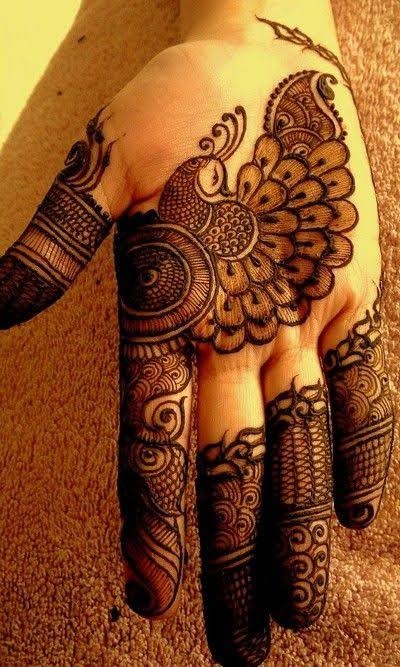

Peacock In Corporate India
The peacock is a favorite motif with corporate India as well. It features frequently on logos, greeting cards as well as in brand names. It features in the logo of the India International Film Festival as well as in several corporate logos.

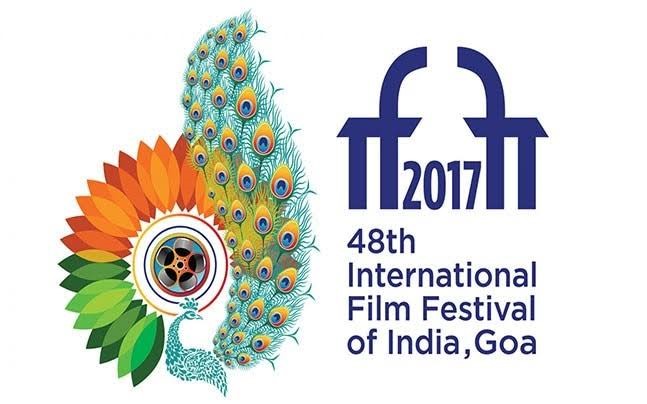
The peacock is a favorite motif of truck owners. Seldom will you see a truck in India that doesn’t have a floridly painted peacock on it. Truck drivers believe that that peacock brings them good luck and keeps them safe from road mishaps.

Conclusion
From the prehistoric cave paintings of Bhimbetka to the contemporary folk art on the back of trucks, the peacock has been one enduring motif that has been present in Indian art scene for thousands of years. The history of Indian art and culture is the history of the national bird of India, the beautiful peacock. The peacock crossed Indian borders to attain global popularity, but it remains an enduring symbol of the Indian civilization.
References:
Lal, Krishna – Peacock in Indian art, thought and literature
Rao, T.A. Gopinath – Elements of Hindu Iconography, Vol. II
Krishna, Nanditha – Sacred Animals Of India
Babbitt, Ellen C – Jataka Tales, Animal Stories
Joshi, N.P. – Bhartiya Murtishastra (Marathi)
Vats, M.S. – Excavations at Harappa
English – Sanskrit Dictionary
Kalidasa – Rutusamhara
Kadgaonkar, Shivendra – The Peacock in Indian Art and Literature, Bulletin of the Deccan College Post-Graduate and Research Institute
Nair, P. Thankappan – The Peacock Cult In Asia
Disclaimer: The opinions expressed in this article belong to the author. Indic Today is neither responsible nor liable for the accuracy, completeness, suitability, or validity of any information in the article.








